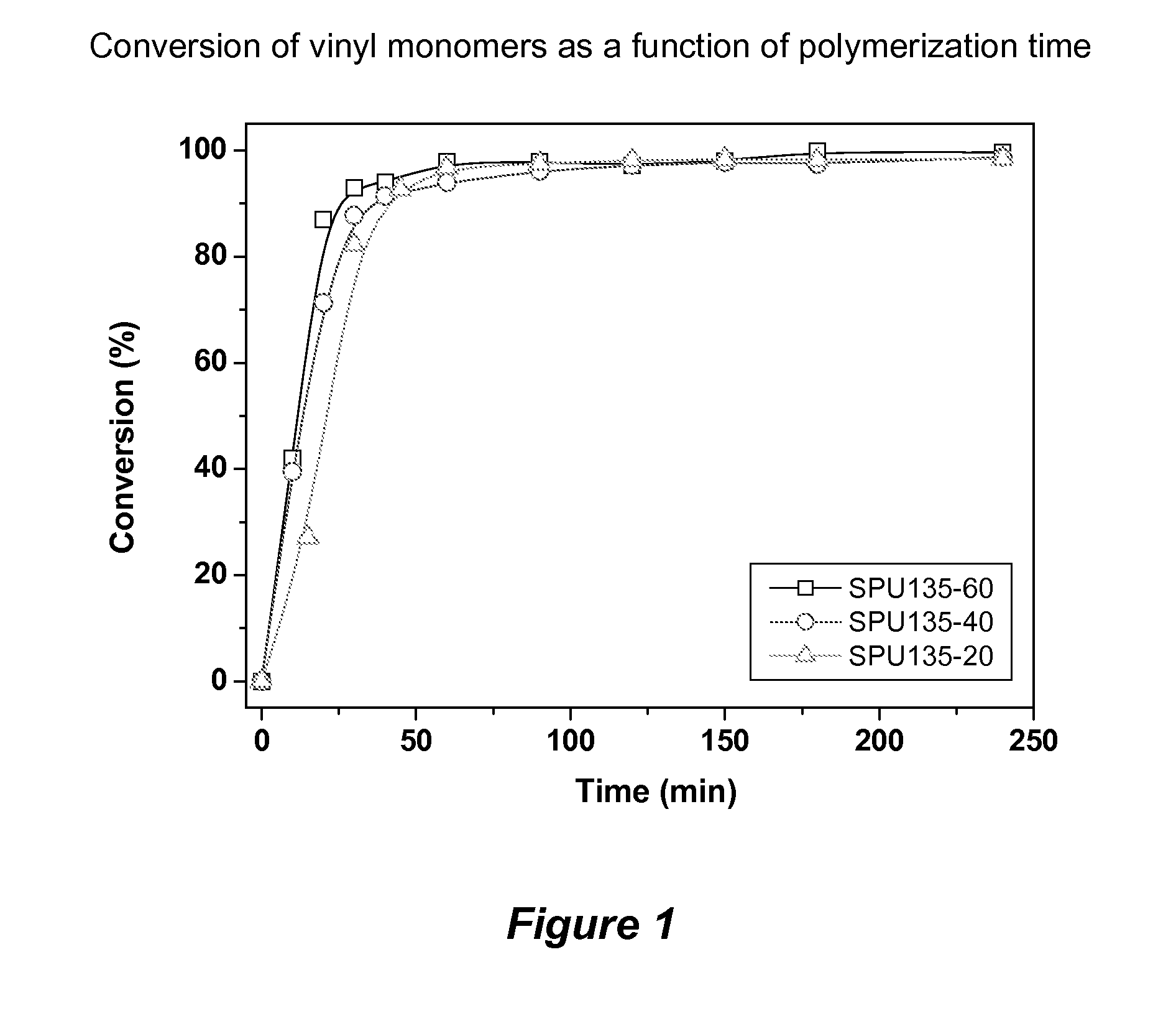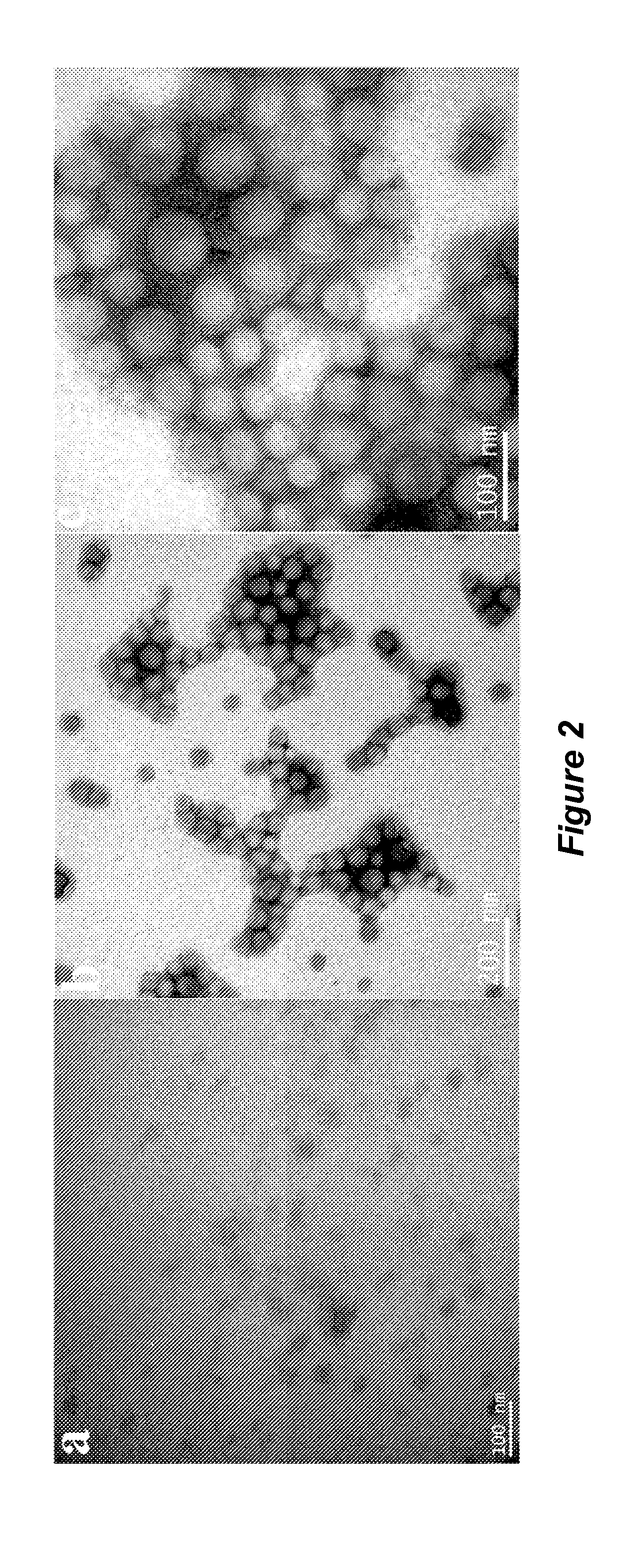Surfactant-free core-shell hybrid latexes
a technology of hybrid latex and core shell, which is applied in the direction of carboxyl rubber coatings, adhesive types, coatings, etc., can solve the problems of coarse mechanical properties of acrylics, reduced film formation, and reduced chemical resistance, and achieves greater tensile strength of files and greater thermal stability
- Summary
- Abstract
- Description
- Claims
- Application Information
AI Technical Summary
Benefits of technology
Problems solved by technology
Method used
Image
Examples
example 1
Preparation of Methoxylated Soybean Oil Polyols (MSOLs)
[0085]Inexpensive, readily available vegetable oil-based polyols are good candidates for the synthesis of environmentally-friendly, waterborne polyurethane dispersions from renewable raw materials, but they also face an important challenge when employing polyols with high hydroxyl functionality. The high functionality of some of these polyols can lead to gelation and higher crosslinking and, therefore, present potential difficulties in dispersing the resulting highly crosslinked PU prepolymers into water. Therefore, only soybean oil-based polyols with a relatively low average hydroxyl functionality of about 2.3 have previously been successfully used for the synthesis of waterborne PU dispersions. To significantly enlarge the potential applications of vegetable oils as raw materials for the development of waterborne PUs with high performance, the successful utilization of highly functionalized vegetable oil-based polyols and the ...
example 2
Preparation of Soybean-Oil-Based Waterborne Polyurethane Dispersions
[0091]Soybean-oil-based waterborne polyurethane (SPU) dispersions were prepared as illustrated in Scheme 2-1.
[0092]The MSOL (15 g), IPDI and DMPA were added to a four-necked flask equipped with a mechanical stirrer, nitrogen inlet, condenser and thermometer. The molar ratio between the NCO groups of the IPDI, the OH groups of the MSOL and the alcohol OH groups of the DMPA is summarized in Table 2-1.
TABLE 2-1Chemical composition, soluble fraction (SF)and crosslink density of the SPU films.Molar ratioaνeNCOHScDMPASF(mol / Sample(IPDI)OHaOHb(wt. %)(wt. %)(%)m3)SPU-1351.71.0 (135)0.6939.35.030.467SPU-1491.71.0 (149)0.6941.95.423.369SPU-149I1.851.0 (149)0.8444.86.419.473SPU-149II2.01.0 (149)0.9947.46.917.970SPU-1761.71.0 (176)0.6945.85.922.485SPU-1901.71.0 (190)0.6947.86.121.6116SPU-2001.71.0 (200)0.6949.06.318.9127aHydroxyl molar ratio of the MSOL (number in parentheses denotes the MSOL OH number).bHydroxyl molar ratio of...
example 3
Core-Shell Hybrid Latexes
[0095]Surfactant-free core-shell hybrid latexes can be readily prepared from soybean oil-based waterborne polyurethanes and poly(styrene-butyl acrylate), as described herein. Conventional emulsion polymerization is carried out using traditional low molecular weight surfactants, which are able to migrate to the polymer surface, resulting in delamination and corrosion. Waterborne polyurethanes are an interesting polymeric material, in which a hydrophilic segment of polyurethane (PU) acts as an internal emulsifier, allowing self-emulsification. Soybean oil-based waterborne PU dispersions have been successfully prepared using methoxylated soybean oil polyol (MSOL) with OH functionality ranging from approximately 2.4 to as high as 4.0 (Biomacromolecules 2008, 9, 3332-3340). The, novel SPU films, which result from drying, exhibit thermophysical and mechanical properties that are comparable to those of PUs from petroleum-based polyols.
[0096]This example describes t...
PUM
| Property | Measurement | Unit |
|---|---|---|
| Temperature | aaaaa | aaaaa |
| Temperature | aaaaa | aaaaa |
| Pressure | aaaaa | aaaaa |
Abstract
Description
Claims
Application Information
 Login to View More
Login to View More - R&D
- Intellectual Property
- Life Sciences
- Materials
- Tech Scout
- Unparalleled Data Quality
- Higher Quality Content
- 60% Fewer Hallucinations
Browse by: Latest US Patents, China's latest patents, Technical Efficacy Thesaurus, Application Domain, Technology Topic, Popular Technical Reports.
© 2025 PatSnap. All rights reserved.Legal|Privacy policy|Modern Slavery Act Transparency Statement|Sitemap|About US| Contact US: help@patsnap.com



